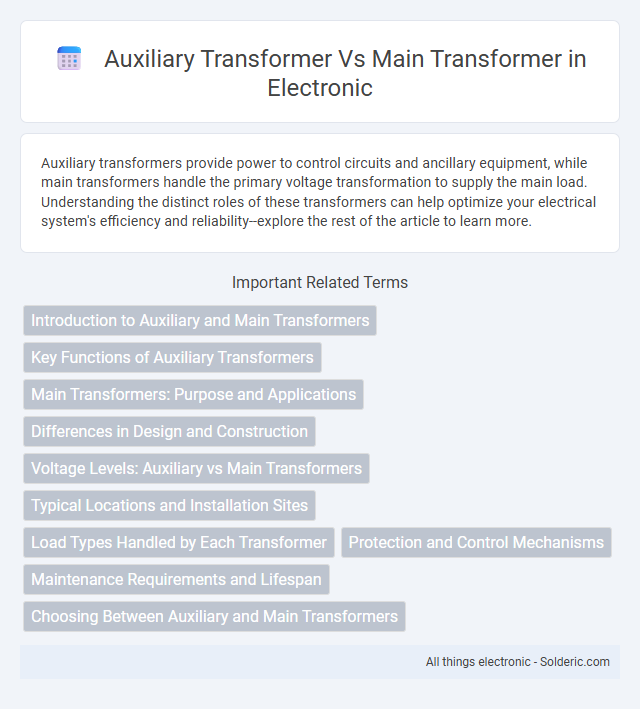Auxiliary transformers provide power to control circuits and ancillary equipment, while main transformers handle the primary voltage transformation to supply the main load. Understanding the distinct roles of these transformers can help optimize your electrical system's efficiency and reliability--explore the rest of the article to learn more.
Comparison Table
| Feature | Auxiliary Transformer | Main Transformer |
|---|---|---|
| Purpose | Supports auxiliary systems like control circuits, instrumentation | Primary power transformation for main load distribution |
| Capacity | Lower power rating (typically < 500 kVA) | Higher power rating (up to several MVA) |
| Location | Located near auxiliary equipment or panels | Installed at power substations or main distribution points |
| Load Type | Feeds control and protection devices, lighting, small motors | Feeds major loads such as industrial machinery and large motors |
| Voltage Levels | Usually low to medium voltage (e.g., 400 V to 11 kV) | Medium to high voltage (e.g., 11 kV to 132 kV or higher) |
| Cooling Method | Natural air cooling or small oil-immersed units | Various cooling methods including oil-immersed and forced air |
| Cost | Lower cost due to smaller size and capacity | Higher cost, suitable for large scale power transfer |
| Typical Application | Auxiliary power supply in plants, control rooms | Main power supply in substations, industrial plants |
Introduction to Auxiliary and Main Transformers
Auxiliary transformers supply power to essential control circuits and auxiliary devices, ensuring smooth operation of the main system. Main transformers handle high voltages, stepping electrical energy up or down to meet primary power distribution needs. Understanding the roles of both transformers allows you to optimize power system efficiency and safety.
Key Functions of Auxiliary Transformers
Auxiliary transformers provide essential low-voltage power supply for control circuits, protection devices, and instrumentation in electrical systems, ensuring reliable operation of the main power equipment. They step down high voltage from the main transformer or the primary supply to safer, usable voltage levels needed for auxiliary loads and monitoring purposes. Your electrical infrastructure depends on these transformers to maintain consistent functionality and operational safety of the entire system.
Main Transformers: Purpose and Applications
Main transformers are essential components in electrical power systems, designed to step up or step down voltage levels for efficient power transmission and distribution. They handle high voltage and power ratings to connect generation stations with substations or industrial loads, ensuring reliable energy delivery. Your infrastructure depends on main transformers for stable voltage regulation and minimizing energy losses across long distances.
Differences in Design and Construction
Auxiliary transformers are designed with smaller capacity and simpler construction compared to main transformers, as they supply power to control circuits and auxiliary equipment. Main transformers feature larger cores, robust insulation, and cooling systems to handle high voltage and power loads essential for primary energy distribution. The difference in winding configuration and core size directly reflects their roles: auxiliary transformers prioritize compactness and efficiency in low-power applications, while main transformers ensure reliability and stability in high-power transmission.
Voltage Levels: Auxiliary vs Main Transformers
Auxiliary transformers typically operate at lower voltage levels, ranging from 110V to 33kV, designed to supply power to control circuits, lighting, and small equipment within industrial plants or substations. Main transformers handle higher voltage levels, often between 110kV and 765kV, facilitating the transmission and distribution of electrical power over long distances. The difference in voltage levels directly impacts their design, insulation requirements, and application within power systems.
Typical Locations and Installation Sites
Auxiliary transformers are typically installed within substations, near process equipment, or on site to supply control, lighting, and auxiliary power, often mounted indoors or in sheltered enclosures to protect sensitive electrical components. Main transformers are generally located at the point of power generation or distribution, such as at power plants, substations, or industrial facilities, with installation sites designed to handle high voltage levels and large mechanical loads, often in outdoor yards or dedicated transformer bays. Site selection for main transformers considers proximity to the power grid and load centers, whereas auxiliary transformers prioritize accessibility and safety for operational support systems.
Load Types Handled by Each Transformer
Auxiliary transformers primarily handle low-voltage loads such as control circuits, lighting, and small motors, ensuring stable power for sensitive equipment. Main transformers manage high-voltage loads, supplying power to large electrical systems and industrial machinery. Your choice depends on the specific load requirements and the scale of the electrical distribution system.
Protection and Control Mechanisms
Auxiliary transformers employ dedicated protection systems such as differential relays and overcurrent protection tailored for low-voltage auxiliary loads, ensuring reliable operation within industrial plants. Main transformers utilize advanced control mechanisms including Buchholz relays, temperature sensors, and tap changers to prevent faults and regulate voltage under high load conditions. Both transformers integrate protective devices like circuit breakers and surge arresters, but main transformers require more sophisticated systems due to their critical role in power transmission and higher fault current levels.
Maintenance Requirements and Lifespan
Auxiliary transformers typically require less maintenance due to their smaller size and simpler design compared to main transformers, which undergo more frequent inspections and oil testing to ensure reliability under heavy load conditions. The lifespan of auxiliary transformers is generally shorter, often lasting 10 to 20 years, whereas main transformers are designed for durability, with lifespans exceeding 30 to 40 years when properly maintained. Your maintenance strategy should prioritize regular monitoring of main transformers to maximize operational life while scheduling basic upkeep for auxiliary transformers to prevent unexpected failures.
Choosing Between Auxiliary and Main Transformers
Choosing between auxiliary and main transformers depends on the specific power distribution needs of your facility. Main transformers handle primary voltage step-down for overall power supply, while auxiliary transformers support secondary systems like control circuits and lighting. Your decision hinges on load requirements, system complexity, and safety standards to ensure optimal performance and reliability.
auxiliary transformer vs main transformer Infographic

 solderic.com
solderic.com